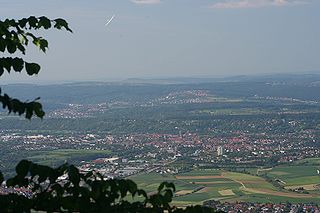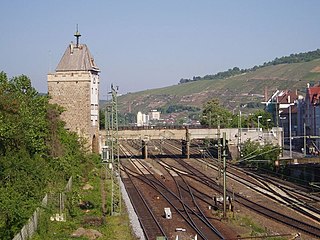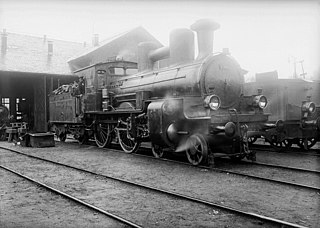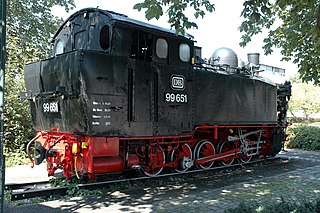
Esslingen am Neckar is a town in the Stuttgart Region of Baden-Württemberg in southern Germany, seat of the District of Esslingen as well as the largest town in the district. Within Baden-Württemberg it is the 11th largest city.
Esslingen is a Landkreis (district) in the centre of Baden-Württemberg, Germany. Neighboring districts are Rems-Murr, Göppingen, Reutlingen, Böblingen and the district-free city Stuttgart.

Swiss Locomotive and Machine Works was a railway equipment manufacturer based in Winterthur in Switzerland. Much of the world's mountain railway equipment was constructed by the company.

Johann Karl Friedrich August Borsig was a German businessman who founded the Borsig-Werke factory.

Kirchheim unter Teck is a town in Baden-Württemberg, Germany, in the district of Esslingen. It is located on the small river Lauter, a tributary of the Neckar. It is 10 km near the Teck castle, approximately 35 kilometres southeast of Stuttgart. It is the fourth city in the Esslingen district, forming a district centre for the surrounding communities.

The Fils Valley Railway designates the Württemberg line from Stuttgart via Göppingen to Ulm. It runs from Plochingen to Geislingen an der Steige through the Fils Valley.

Emil Julius Carl Kessler was a German businessman and founder of the Maschinenfabrik Esslingen.

The Royal Württemberg State Railways were the state railways of the Kingdom of Württemberg between 1843 and 1920.

The Württemberg Hz were 0-10-0 rack and adhesion steam locomotives, that were initially developed by the Royal Württemberg State Railways, but were delivered to the Deutsche Reichsbahn-Gesellschaft (DRG) in the mid-1920s.

The Maschinenbau-Gesellschaft Karlsruhe was a locomotive and railway wagon manufacturer in the early days of the German railways. It was based at Karlsruhe in what is now the state of Baden-Württemberg in southwestern Germany.

The Württemberg AD was a German steam locomotive built for the Royal Württemberg State Railways. It was an express train engine with a 4-4-0 wheel arrangement and was built from 1899 by the Maschinenfabrik Esslingen. Up to that point the railway only had increasingly elderly locomotives with a 2-4-0 configuration.
The Württemberg Class B and Class B2 engines were steam locomotives with the Royal Württemberg State Railways first built in 1868 by the Maschinenfabrik Esslingen in Esslingen in the former Kingdom of Württemberg in southern Germany.

The Sächsische Maschinenfabrik in Chemnitz was one of the most important engineering companies in Saxony in the second half of the 19th century and the first two decades of the 20th century. Including its various predecessor businesses, the firm existed from 1837 until its liquidation in 1930, and individual branches of the company taken over by others continued to operate until 1990. The company is closely linked with the name of its founder and long-time manager, Richard Hartmann, whose name formed part of the new company title in 1898: the Sächsische Maschinenfabrik vormals Richard Hartmann.

Then locomotives of Württemberg Class A were express train steam locomotives operated by the Royal Württemberg State Railways. They were built from 1878 by the Maschinenfabrik Esslingen engineering works.

In 1908 the Royal Württemberg State Railways placed an order with the Maschinenfabrik Esslingen for a powerful passenger tank locomotive. Classified as the Württemberg T 5, this superheated engine was designed for duties on Württemberg's main and branch lines and had the very long fixed wheelbase of 4,000 mm in order to give the locomotive smooth riding qualities. By 1920 a total of 96 engines had been manufactured. In 1919, three examples had to be give to France; the remaining 93 were taken over by the Deutsche Reichsbahn and 89 survived into the Deutsche Bundesbahn fleet. From 1959 they began to be retired. The last one was taken out of service in 1963 and was kept at Aulendorf as a museum engine until 1968. This last example was then scrapped as well.

The Prussian Class T 14.1 was a German 2-8-2T, goods train, tank locomotive operated by the Prussian state railways and the Royal Württemberg State Railways. They were later incorporated by the Deutsche Reichsbahn into the DRG renumbering plan for steam locomotives as DRG Class 93.5–12.

Richard Hartmann was a German engineering manufacturer.

Esslingen (Neckar) station is the most important station in the town of Esslingen am Neckar in the German state of Baden-Württemberg and is located 13.2 kilometres (8.2 mi) from Stuttgart Hauptbahnhof on the Fils Valley Railway.

The Flamatt–Laupen–Gümmenen railway line is a line in Switzerland that was built and formerly operated by the Sense Valley Railway. The 11.5 km-long standard-gauge line on the Flamatt–Laupen–Gümmenen route through the Sense valley was opened on 20 January 1904. The shares of the company were acquired by the Swiss Federal Railways (SBB) and Swiss Post (34 %) in 2001. Since then, the infrastructure of the Sense Valley Railway has been operated by the SBB under contract.

The Saxon VI K were a class of 750-mm gauge 0-10-0T locomotives of the Royal Saxon States Railways with a gauge of 750 mm. In 1925 the Deutsche Reichsbahn (DRG) grouped the locomotives into class 99.64–65; from 1923 to 1927 the procured more locomotives of this type which were grouped in to class 99.67–71.






















